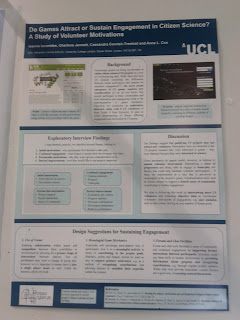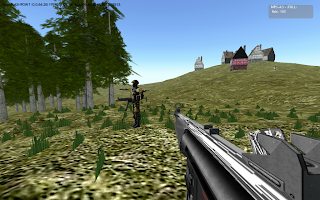H809: End of block 2
Well, everyone seems to have been busy with their second assignment so there's not been a massive amount of activity online for H809 the last couple of weeks. I did finally get around to reading the last few papers but have been pretty busy myself as I've been preparing for my upcoming probation report. And I'm probably going to be quite busy with this for a while, as it's essentially a test of whether I sound like I have a good enough grasp on what I want to do, why it's worth doing and how I'm going to do it, so I can prove I'm ready for my second year of PhD study. If it sounds straight forward, it's not as these are surprisingly difficult questions to answer but I'm sure that the whole process means I'm at least going to come up with a plan! But yes, I'm probably going to be a bit quiet over the next couple of weeks (at least until my report is due in on May 18th) though I will be keeping an eye on what's happening on the blogs at least.
Back to H809 though. In terms of the readings, Juliette has posted summaries and her own reflections for Weeks 8 and 9.Week 8 involved reading the Tolmie (2001) and Crook & Dymott (2005) papers to introduce students to different socio-cultural perspectives, while Week 9 looked at Activity theory (cultural-historical activity theory to be precise) and how it might be useful in practice via the Jonassen & Rohrer-Murphy (1999) paper. As part of the activities for week 8, students were asked to consider tools for social bookmarking. Some of the suggestions include:
Diigo (used to be Furl) which allows you to highlight web pages and use post-its
Delicious as it helps store relevant site links, including YouTube clips, and it allows you to tag and see other tags of urls into bundles. At the time of writing, there seems to be 90 delicious tags for H809...
Citeulike which comes across as more academic, though apparently didn't seem particulalry intuitive
Zotz for the Zotero plugin on Firefox, though the problem here is not knowing enough people who use it
With respect to the readings for Week 8, the issues that came up where the fact that maybe learning theories don't need to be mutually exclusive, that the word "context" doesn't always mean the same thing (does gender really count as context? c.f. Tolmie paper) and how the theory adopted by the researchers informs how the goals of the research are assessed. A link was posted to a paper available on ACM by Rousou and colleagues (1999) - you will need to be logged in to access it though - to illustrate how theoretically driven approaches have been used to analyse learning.
For Week 9, one of the key things identified concerning Activity Theory (AT) was how it emphasises that all meaningful activity is related to the environment in which it occurs. This entails the study of activity in authentic situations, rather than within a lab for example. However, this means there will probably be factors that will not be taken into account during the research process, as it is impossible to control for everything, so researchers need to be aware of this when interpreting the findings. Juliette also pointed out that while the approach outlined by Jonassen & Rohrer-Murphy to using AT to guide the design of learning environments might be quite useful, there might be problems applying to certain cases e.g. pure mathematics. Oh, and I really liked the findings the sentence that described AT as a "primarily descriptive tool rather than a prescriptive theory" (p. 68) because I think I said something along these lines in response to Juliette's posts and now I can back it up with a quote!
In terms of my own research, I can't say I found the last couple of weeks activities have been particularly inspiring. The main point I've taken from the readings and thinking about socio-cultural theories is the importance of context, and how you define it. The more I think about it, the stranger it seems to try and look at learning in isolation - so with respect to my own work, if I can't get access to "natural" settings where game play occurs, I would try and replicate those sort of conditions within a lab as much as possible. Plus, if I'm going to look at more than one player, it would be better to get them to play with (or against) friends or family members i.e. the people they would normally play with. Otherwise, I'm probably not going to be able to observe the sort of informal learning and engagement they would normally experience. I think the activity theory triangles help to visualise how the relationship between the subject and object is mediated by the tool(s) - and how one can affect the other and vice-versa. It's also useful for considering what constitutes context in terms of division of labour, community and rules. So, it might be helpful for thinking about what aspects to pay attention too. I'm not sure at this point if I'm going to be using AT for my own analysis but it's definitely helped me to consider the broader picture.
Back to H809 though. In terms of the readings, Juliette has posted summaries and her own reflections for Weeks 8 and 9.Week 8 involved reading the Tolmie (2001) and Crook & Dymott (2005) papers to introduce students to different socio-cultural perspectives, while Week 9 looked at Activity theory (cultural-historical activity theory to be precise) and how it might be useful in practice via the Jonassen & Rohrer-Murphy (1999) paper. As part of the activities for week 8, students were asked to consider tools for social bookmarking. Some of the suggestions include:
Diigo (used to be Furl) which allows you to highlight web pages and use post-its
Delicious as it helps store relevant site links, including YouTube clips, and it allows you to tag and see other tags of urls into bundles. At the time of writing, there seems to be 90 delicious tags for H809...
Citeulike which comes across as more academic, though apparently didn't seem particulalry intuitive
Zotz for the Zotero plugin on Firefox, though the problem here is not knowing enough people who use it
With respect to the readings for Week 8, the issues that came up where the fact that maybe learning theories don't need to be mutually exclusive, that the word "context" doesn't always mean the same thing (does gender really count as context? c.f. Tolmie paper) and how the theory adopted by the researchers informs how the goals of the research are assessed. A link was posted to a paper available on ACM by Rousou and colleagues (1999) - you will need to be logged in to access it though - to illustrate how theoretically driven approaches have been used to analyse learning.
For Week 9, one of the key things identified concerning Activity Theory (AT) was how it emphasises that all meaningful activity is related to the environment in which it occurs. This entails the study of activity in authentic situations, rather than within a lab for example. However, this means there will probably be factors that will not be taken into account during the research process, as it is impossible to control for everything, so researchers need to be aware of this when interpreting the findings. Juliette also pointed out that while the approach outlined by Jonassen & Rohrer-Murphy to using AT to guide the design of learning environments might be quite useful, there might be problems applying to certain cases e.g. pure mathematics. Oh, and I really liked the findings the sentence that described AT as a "primarily descriptive tool rather than a prescriptive theory" (p. 68) because I think I said something along these lines in response to Juliette's posts and now I can back it up with a quote!
In terms of my own research, I can't say I found the last couple of weeks activities have been particularly inspiring. The main point I've taken from the readings and thinking about socio-cultural theories is the importance of context, and how you define it. The more I think about it, the stranger it seems to try and look at learning in isolation - so with respect to my own work, if I can't get access to "natural" settings where game play occurs, I would try and replicate those sort of conditions within a lab as much as possible. Plus, if I'm going to look at more than one player, it would be better to get them to play with (or against) friends or family members i.e. the people they would normally play with. Otherwise, I'm probably not going to be able to observe the sort of informal learning and engagement they would normally experience. I think the activity theory triangles help to visualise how the relationship between the subject and object is mediated by the tool(s) - and how one can affect the other and vice-versa. It's also useful for considering what constitutes context in terms of division of labour, community and rules. So, it might be helpful for thinking about what aspects to pay attention too. I'm not sure at this point if I'm going to be using AT for my own analysis but it's definitely helped me to consider the broader picture.



Comments
Post a Comment